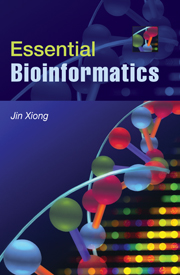Book contents
- Frontmatter
- Contents
- Preface
- SECTION I INTRODUCTION AND BIOLOGICAL DATABASES
- 1 Introduction
- 2 Introduction to Biological Databases
- SECTION II SEQUENCE ALIGNMENT
- SECTION III GENE AND PROMOTER PREDICTION
- SECTION IV MOLECULAR PHYLOGENETICS
- SECTION V STRUCTURAL BIOINFORMATICS
- SECTION V GENOMICS AND PROTEOMICS
- APPENDIX
- Index
- Plate section
- References
1 - Introduction
Published online by Cambridge University Press: 05 June 2012
- Frontmatter
- Contents
- Preface
- SECTION I INTRODUCTION AND BIOLOGICAL DATABASES
- 1 Introduction
- 2 Introduction to Biological Databases
- SECTION II SEQUENCE ALIGNMENT
- SECTION III GENE AND PROMOTER PREDICTION
- SECTION IV MOLECULAR PHYLOGENETICS
- SECTION V STRUCTURAL BIOINFORMATICS
- SECTION V GENOMICS AND PROTEOMICS
- APPENDIX
- Index
- Plate section
- References
Summary
Quantitation and quantitative tools are indispensable in modern biology. Most biological research involves application of some type of mathematical, statistical, or computational tools to help synthesize recorded data and integrate various types of information in the process of answering a particular biological question. For example, enumeration and statistics are required for assessing everyday laboratory experiments, such as making serial dilutions of a solution or counting bacterial colonies, phage plaques, or trees and animals in the natural environment. A classic example in the history of genetics is by Gregor Mendel and Thomas Morgan, who, by simply counting genetic variations of plants and fruit flies, were able to discover the principles of genetic inheritance. More dedicated use of quantitative tools may involve using calculus to predict the growth rate of a human population or to establish a kinetic model for enzyme catalysis. For very sophisticated uses of quantitative tools, one may find application of the “game theory” to model animal behavior and evolution, or the use of millions of nonlinear partial differential equations to model cardiac blood flow. Whether the application is simple or complex, subtle or explicit, it is clear that mathematical and computational tools have become an integral part of modern-day biological research. However, none of these examples of quantitative tool use in biology could be considered to be part of bioinformatics, which is also quantitative in nature.
- Type
- Chapter
- Information
- Essential Bioinformatics , pp. 3 - 9Publisher: Cambridge University PressPrint publication year: 2006



